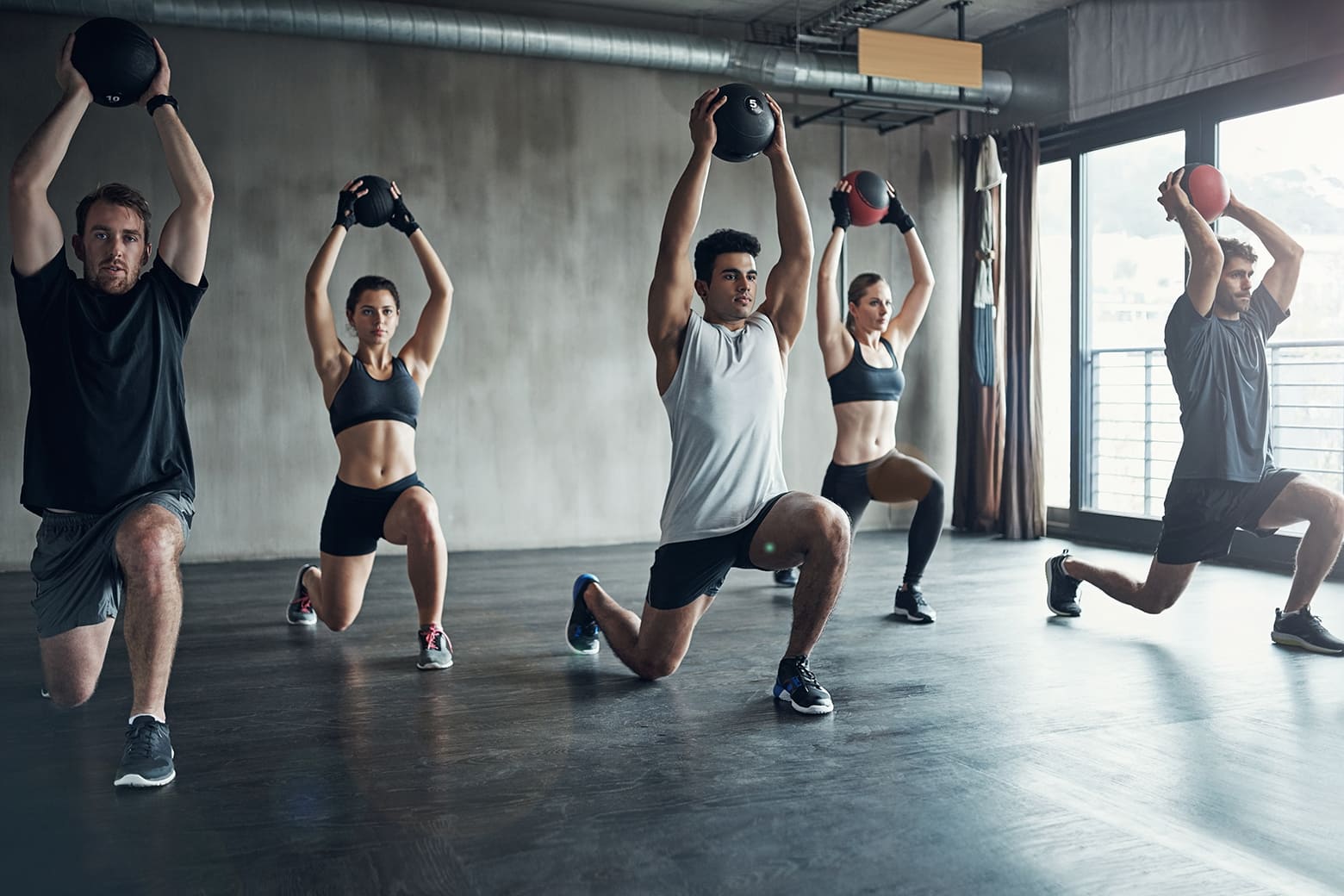
by Glendale Sports Center | Dec 17, 2018 | Feature Story Middle Left
by Alison Chism
A popular New Year’s resolution for many people is to eat
healthier, begin exercising and lose weight. Yet, a common question is how to
kick-start an exercise program that provides the most benefit? This leads us to
what are fast fat burners and how can you get the most results from your
workout? Here are three strategies to keep in mind as you start the New Year.
Begin Strength Training
Everyone has probably heard how great strength training is
for your body. But you might not realize how critical it is for burning fat.
Calories are the fuel that creates energy, which keeps our
bodies going throughout the day. These calories must be burned, or they will be
stored as fat. When you strength train, you “break down” muscles in order to
build them back up stronger. In doing this, our muscles need to consume a lot
of calories. And, the more we break down our muscles and force them to repair
themselves, the more calories we burn. In addition, the more muscle we have,
the more calories will be burned to fuel them.
For example, consider two individuals who each weigh 150
pounds. One has a body fat percentage of 40%, making their remaining 60% lean
body mass of muscle and water weight. The other individual has a body fat
percentage of 25%, making their remaining 75% lean body mass. What does this
mean? The individual who has a higher percentage of lean body mass will burn
more calories to fuel their muscles rather than storing the calories as fat.
Additionally, because our muscles need so much fuel,
strength training makes our bodies continue to burn more calories even after
working out, up to 39 hours!
Consume Enough Protein
Protein is the main macronutrient that feeds our muscles and
bodies to keep them strong. As stated, having a stronger body with more muscle
will organically burn more calories than having less muscle. Therefore, we need
to ensure we are consuming enough protein to help keep our bodies strong.
Protein can also help increase or regulate metabolism. This
is because our bodies burn calories when we are digesting food. This is called
the thermic effect of food. It is estimated that 20% to 35% of calories are
burned during digestion when we eat protein-rich food. When we eat fat and
carbohydrates, we only burn 5% to 15%.
Sleep, Sleep, Sleep
…And More Sleep
Finally, getting enough sleep every night is arguably the
most important component to living healthy and burning fat. Think of when your
computer shuts down and reboots. It requires a certain amount of time to be
completed or else the programs do not run successfully or efficiently. Our
bodies are the same way. When we go to sleep at night, our bodies are shutting
down in order to reboot for the next day. If we do not give our bodies enough
time, then our bodily functions get messed up and do not run properly. These
functions can include our metabolism, hormones, ability to deal with stress,
and brain function.
Getting active and raising your heart rate is always good
for you, and committing to an exercise program is a great way to start a New
Year. By adding fat burners to your routine, you can make sure your workout is
working as hard as you are.
Alison Chism is the Health & Wellness Director at the
YMCA Glendale Sports Center at Infinity Park. She is certified as an ACSM
Personal Trainer, ACE Health Coach and TRX Suspension Trainer. She is also
certified in ACSM Exercise is Medicine. She has a Bachelor of Science degree in
Health Promotion and is pursuing a Master’s Degree in Health and Wellness
Management.

by Mark Smiley | Nov 19, 2018 | Feature Story Middle Left
by Libby Barrett
Stress during the holidays is common. In fact, it’s even expected. But it’s not something people should just accept. Stress anytime of the year should be held at bay. Here’s what you can do to take the season in stride.
The Effects Of Holidays
It first helps to understand why stress is so rampant this time of year. The American Psychological Association reports that the stress of the holidays has three main culprits: money, time and commercialism.
People feel pressure to give gifts while at the same time not overspending or going in debt. Additional stress comes from growing pressures to shop, wrap, plan meals, and prep for celebrations. Feelings of loneliness can also increase this time of year.
During the holidays and year-round, it’s important to get a handle on this stress. This is because when we’re under stress, our bodies release cortisol and other stress hormones, which can negatively affect our health. Further, the Mayo Clinic explains that long-term stress can lead to anxiety, depression, digestive problems, headaches, heart disease, sleep problems, weight gain, and memory and concentration impairment.
the Mayo Clinic explains that long-term stress can lead to anxiety, depression, digestive problems, headaches, heart disease, sleep problems, weight gain, and memory and concentration impairment.
To counter these risks, these six strategies can help.
Stay active. Physical exercise is known to relieve stress. Research shows it stimulates the production of endorphins and enkephalins, which are the body’s natural feel-good hormones. Based on this, as time-crunched as the holidays may seem, it is important to stick with your exercise routine.
Grab a buddy and go to a class together, which will also combat feelings of isolation that can increase around the holidays. Also, when shopping, park your car far from the entrance so you’ll get some extra steps in. If you’re going out of town, research exercise options where you’ll be. Many gyms do trial or out-of-town packages. Or find some fun exercise routines online that don’t require a gym or equipment.
Don’t over commit. Remember that saying no doesn’t make you a scrooge. If you have to decline a few party invites, it’s okay! During the holidays, it’s important to make time for you. Take care of yourself and family by maintaining your routine as much as possible and getting plenty of rest.
Set a budget. Before you start shopping, establish how much you truly have to spend on gifts and adhere to your budget. It can be easy to get carried away with lavish last-minute presents, but keep in mind it’s the thought that counts. Expenses quickly add up and can create stress going into the new year, especially if you’re holiday shopping on credit.
Stay hydrated. During the holidays, alcohol is often the beverage of choice at many events. While a festive cocktail can take off the stress initially, overindulging can lead to dehydration. Be sure to drink plenty of water to stay hydrated and drink alcohol responsibly.
Try yoga. Yoga is an ancient mind-body practice that focuses on connecting breath with movement, which studies say can engage the parasympathetic nervous system and promote relaxation, digestion, and a sense of calm. And yoga may help reduce stress and anxiety, while enhancing mood and overall wellbeing.
You don’t have to be a master Yogi to try this beneficial exercise. There are classes for all levels and skillsets, and some that don’t even require floor work.
Practice gratitude. Finally, when you’re feeling stressed, try to think of four or five things that you’re grateful for. Experts say cultivating gratitude is one of the best ways to improve emotional well-being and increase satisfaction and happiness. Especially during the consumerism of the holidays, take the time to slow down, reflect on what you have, and be grateful.
and increase satisfaction and happiness. Especially during the consumerism of the holidays, take the time to slow down, reflect on what you have, and be grateful.
This holiday season, relax and focus on peace and happiness. Stay in the moment and try to keep a handle on stress.
Libby is a certified yoga and group fitness instructor and holds specialty certifications in Barre, Silver Sneakers, and BodyPump. She always incorporates cross-training to improve total health and wellness. Her goal is to help everyone love their body while building strength and confidence.

by Glendale Sports Center | Oct 24, 2018 | Feature Story Middle Left
by Mcyveton Pierre-Louis
 We all hear that it’s important to get sufficient sleep. But maybe we’re not sure why — especially since the things we need to do to be healthy typically involve exercising and eating right. Why then are sleep and relaxation so important to overall fitness and wellness?
We all hear that it’s important to get sufficient sleep. But maybe we’re not sure why — especially since the things we need to do to be healthy typically involve exercising and eating right. Why then are sleep and relaxation so important to overall fitness and wellness?
The reasons are plenty. Mentally, getting the correct amount of quality sleep is essential to your ability to learn and process memories. It helps you be well rested so you can concentrate and focus throughout the day. Physically, sleep helps restore your body’s energy and repair muscle tissue. It also triggers the release of hormones that affect growth and appetite.
How much sleep do I need?
How much sleep you need varies based on age. The National Heart, Lung and Blood Institute recommends at least 11 to 12 hours per night for preschool-aged children, 10 hours for school-aged children, nine to 10 hours for teens, and seven to eight hours for adults.
Getting in those hours is important, but it’s also essential that the sleep is good quality. Frequent interruptions or not getting enough deep REM sleep can diminish the benefits.
Many people think older people need less sleep. Another myth is that people can “make up” lost sleep on the weekends, or that just losing an hour or so of sleep a night will not have adverse effects. The reality is that older people are more apt to have insomnia or medical conditions that disrupt sleep. And losing sleep at any time, consistently, at any age, can eventually affect your health.
If I can’t sleep, will just relaxing help?
While relaxation is not a substitute for sleep, it can be beneficial for relieving stress and anxiety, which can promote sleep. Relaxation techniques can include meditating, laying down resting, or focusing on deep breathing.
What if I have problems falling asleep?
Knowing the importance of sleep can be frustrating if you’re struggling to get enough of it. And if you do have difficulties falling and staying asleep, you are not alone. According to the Sleep Health Foundation, one out of three people experience at least mild insomnia, and women are twice as likely to have insomnia than men.
If getting sleep is challenging for you, try these tips:
- Stick to a routine. Aim to head to bed and wake up around the same time each day.
- Unplug. Try not to watch TV or work on your computer in bed. Stop an hour beforehand so your mind has time to unwind.
- Exercise. Getting the appropriate amount of exercise benefits nearly all aspects of your health, including sleep. Adults should strive for two and a half hours of moderate activity per week, and children need one hour per day. Try to increase your activity, but be sure to stop exercising two to three hours before bedtime.
- Create a sleep environment. Make sure you have the appropriate surroundings — a dark room, a good mattress, and a pillow that supports your head and neck.
- Avoid caffeine and nicotine. These are stimulants that can disrupt sleep. And smoking can cause you to wake up early due to nicotine withdrawal.
- Skip the late-night meal. Snacking is okay, but eating a large meal before bed can cause indigestion, which can disrupt sleep.
- Relax before bed. Take a hot bath, listen to music, or read.
- Do not force it. If you’re unable to fall asleep within 20 minutes, return to a relaxing activity. Lying in bed awake can result in anxiety or stress that will make falling asleep even more difficult.
Sleeping provides essential benefits, both physically and mentally. And getting enough sleep can help you stay focused, reduce stress, and function at your best.
Mcyveton Pierre-Louis is the Member Experience Director at the Littleton Family YMCA. Certified by LiveStrong, NSCA, and YMCA, Mcyveton believes exercise is about a lifestyle change. He loves to help people reach their goals and push to the next level.

by Mark Smiley | Oct 2, 2018 | Feature Story Middle Left
by Kyle Wheeler
Have you heard of functional strength training? What exactly does that mean, and is it something you should incorporate into your fitness routine? The answer is yes! More than a buzzword in the health world, functional fitness can give you the overall strength you need to stay active throughout your life.
First off, what is functional strength? It’s what helps us physically take on the challenges we face in everyday life — carrying groceries, mowing the lawn, or climbing stairs. Without functional strength, these tasks get more and more difficult through the years, and we find we’re not able to do things “like we used to.”
The extent of functional strength you need varies by individual — some people’s lifestyles involve playing sports or running races. Others just need the strength and stamina to work in the garden or to play with the grandkids.
Training is tailored to individual needs and goals, and can be done by active older adults, elite athletes or teens and kids. Regardless of your level, functional strength can build muscle and bone mineral density that diminish as we age. It also allows you to add unique and fun movements to your activity repertoire, which in turn can stave off aging-related concerns.
To incorporate functional strength training into your routine, here are four factors to keep in mind:
- First, be fit.
Before starting a training program, establish a good base of cardiovascular health. Assess your overall fitness on your own or consult with a personal trainer. Also, don’t begin functional strength training without having done some steady resistance training using proper form.
- Explore the moves.
Functional strength exercises differ from other movements in that they engage multiple muscle groups. Instead of doing isolated exercises that may work the legs or arms, functional strength exercises incorporate broader movements that not only improve strength but also boost balance and improve joint control. Because of this, they help reduce the risk of injury you might experience in doing everyday “functional” activities.
Functional strength movements include:
- Suspension training
- Plyometric bodyweight movements
- Kettlebell training
- Mega-medicine ball training
- Battle rope exercises
- Olympic lifting
- Sandbag workouts
- Fully engaging core exercises beyond typical crunches or sit-ups
- Push-sled workouts
- High-Intensity Interval Training
- Balance work
- Stability (physio-ball) ball exercises
- Add a few moves slowly over time.
That said, don’t just jump in and try to tackle all these moves at once. Start by adding just one or two to your existing routine. For example, at the end of your current workout, try adding three 30-second sets of full-out battle rope movement. Aim to have great form — a neutral spine, tight core and stable base.
The next week, add kettlebell swings into the mix, and so on. If you choose something more difficult like Olympic lifting, make sure to do the lifts before your workout, instead of adding them on at the end. You don’t want to be doing the most difficult exercises last!
- Have fun.
As you incorporate functional strength training into your routing, celebrate the added flexibility, balance, and muscle you’re bringing to your life. Most importantly, as you train, remember to have fun. If you find you’re not looking forward to your workout, figure something else out. The beauty of functional strength training is that it comes with variations and new possibilities to explore. You don’t have to do moves you don’t care for — there are always more options.
Functional strength can keep you active and engaged and able to do the things “you’ve always done.” Stay strong!
Kyle Wheeler, NASM-CPT, is a Certified Wellness Coach and Fitness Coordinator. A personal trainer, certified pool operator, and small group instructor, Kyle has a master’s degree in exercise science and health promotion. He is a self-proclaimed nutrition nut who trains with a focus on core stability and functional strength. Kyle teaches at the Schlessman Family YMCA.

by Mark Smiley | Aug 24, 2018 | Feature Story Middle Left
by Alison Chism
With today’s busy schedules, it can be challenging for families to create and maintain healthy lifestyles. Yet, it’s an important task to take on. In the United States, obesity rates among children have doubled since 1980, and over 60% of adults are considered overweight or obese. The good news is that by influencing your family’s physical activity, nutrition and social environment you can instill healthy habits that will last a lifetime. Here are four ways to start.
Take The Team Approach
When it comes to being healthy together, the key word is together. Working toward a healthy lifestyle as a family helps strengthen relationships and it gives kids a role model for being active and eating right. Also, a team approach creates a group mentality. By emphasizing the importance of doing things as a family, you will be more apt to be successful than you would be on your own.
Plan And Cook Meals Together
Studies show that when families cook and eat meals together, children are more likely to view nutrition as a positive experience. Eating meals together also creates time for bonding and building relationships. Tackling proper nutrition may seem daunting, but aiming for this as a family can make it easier. Involve everyone in planning, shopping, and preparing meals.
Be Active Together
Another way to be healthier as a family is to make fitness part of your routine. Make an “appointment” to take a walk after dinner at least three times per week. If you have it planned and on the schedule (like a doctor’s visit or deadline), you’ll be more likely to follow through. In addition, over time it will become more of a habit instead of a task on your list.
Also do a search for local parks to visit, trails to bike, and playgrounds to explore. Bring a frisbee or other toys. Remember, physical activity means incorporating movement into your day. It doesn’t always have to mean going to the gym.
Identify Family Rewards Together
To stay motivated and positive, rewarding yourself is critical in any healthy lifestyle change. Sit down as a family and identify rewards for hitting milestones in your journey, such as walking a 5k together, trying a new sport, or adding a certain number of healthy meals to your rotation.
Doing this as a family helps build stronger relationships and increases support for each other. Try to choose different kinds of rewards, for example, new tennis shoes for everyone, a night out together at the movies and a favorite restaurant, or even a trip to the beach or mountains. Start with small rewards for reaching short-term goals, and work toward larger rewards for long-term goals.
Getting fit as a family is not only healthy, it’s also fun. You’ll create healthy habits and great memories, all at the same time. For more strategies for healthy living, contact the fitness professionals at the YMCA.
Alison Chism is the Health & Wellness Director at the YMCA Glendale Sports Center at Infinity Park. She is certified as an ACSM Personal Trainer, ACE Health Coach and TRX Suspension Trainer. She is also certified in ACSM Exercise is Medicine. She has a Bachelor of Science degree in Health Promotion and is pursuing a Master’s Degree in Health and Wellness Management.

by Mark Smiley | Jul 20, 2018 | Feature Story Middle Left
Three Reasons It’s Never Too Late To Start Working Out
by Nick Fortune
Stronger bones. Your bones are constantly going through a process called “remodeling,” in which new bone formations are being created and old ones are being broken down. Bone mass peaks when you’re in your late 20s or early 30s. Then, as we age, it begins to break down more than build up.
If the bone mass gets too low, osteoporosis can develop. This is a condition in which bones are weak and brittle, making them more susceptible to fractures and breaks. More than 44 million Americans age 50 and older have osteoporosis or low bone mass.
The good news is that exercise, specifical-ly weight-bearing exercise, has been proven to help increase or maintain bone density even as we continue to age.
Examples of weight-bearing exercises include walking, weight training, climbing stairs, dancing, running on the treadmill and using the elliptical. Bones respond to the mechanical forces and stress placed upon them.
If you have osteopenia or osteoporosis, or think you may have low bone mass, check with your doctor before beginning or increasing your amount of physical activity.
More muscle. Muscle, just like bone, also builds up and breaks down constantly throughout your lifetime. Your muscle mass peaks in your 30s and after that you begin to naturally lose muscle mass and function.
Physically inactive people can lose anywhere from three to five percent of their muscle mass each decade after the age of 30. Sarcopenia, the decline of muscle mass due to aging, affects nearly 30% of adults ages 60 to 70 and roughly 50% of adults over 80.
Cardiovascular exercise on its own, such as walking, elliptical machines and exercise bikes, is great for your heart and lungs, however strength training and resistance training can help increase or maintain muscle mass, starting at any age. The Centers for Disease Control and Prevention recommends that adults perform moderate or high-intensity muscle-strengthening activities that involve all major muscle groups two or more days a week.
Smarter brains. While physical activity improves health and reduces your risk for disease, it also benefits people mentally. Working out improves mood, reduces stress, and increases energy levels.
Even better, exercise can also improve brain function and memory. Physical activity stimulates the release of certain chemicals in the brain that protect brain cells from degenerating over time. Research has shown that regular moderate-intensity physical activity can increase the size of some brain regions, including the prefrontal cortex, medial temporal cortex and hippocampus, which help form, organize and store memories and consolidate short-term memory into long-term memory.
The Centers for Disease Control and Prevention recommends that adults get 150 minutes of moderate physical activity a week. If you’re not there yet, do what you can and gradually add 5 to 10 minutes of exercise a week until you reach your goal.
You don’t need a lifetime of exercise to get the benefits of stronger bones, more muscle, and increased brain function. Whatever you do — starting at any time, at any age — can make a difference. It’s not too late, ever. Start where you are and get going!
Nick Fortune is the Active Older Adult Coordinator at the Schlessman Family YMCA. Fortune is an American Council on Exercise (A.C.E.) Certified Personal Trainer and Group Exercise Instructor as well as an A.C.E. Orthopedic Exercise Specialist and Functional Training Specialist.







